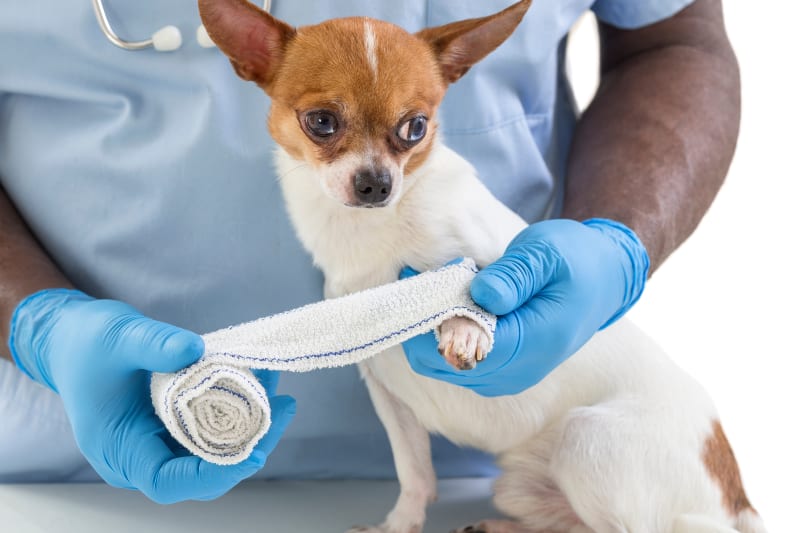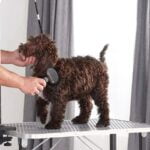Table of Contents
How to clean pet wounds is a crucial skill for pet owners. Pets can easily get injured, whether it’s a minor scrape or a more serious cut. Proper wound care is essential to prevent infection and promote healing. This guide outlines the seven essential steps for cleaning and managing pet wounds effectively.

Step 1: Assess the Wound
Before you start cleaning, carefully assess the wound. Determine the severity and type of injury. Minor scrapes and cuts can often be treated at home, while deeper wounds or those with excessive bleeding may require veterinary attention. If you’re unsure, it’s always best to consult your veterinarian. Knowing how to clean pet wounds properly starts with understanding the extent of the injury.
Step 2: Gather Necessary Supplies for Cleaning Pet Wounds
Having the right supplies on hand makes the cleaning process smoother. You will need:
- Clean towels or gauze pads
- Sterile saline solution or warm water
- Antiseptic solution (chlorhexidine or betadine)
- Hydrogen peroxide (for initial cleaning only)
- Antibiotic ointment
- Bandages or dressing materials
- Scissors or clippers (to trim hair around the wound)
- Elizabethan collar (to prevent licking and chewing)
Step 3: Restrain Your Pet for Safe Wound Cleaning
To clean the wound safely, restrain your pet to prevent sudden movements. You can gently wrap your pet in a towel or use a leash and harness. Having a second person to help hold your pet can make the process easier and safer. Proper restraint is essential when learning how to clean pet wounds.
Step 4: Clean the Pet Wound
Start by rinsing the wound with sterile saline solution or warm water to remove debris and dirt. Avoid using hydrogen peroxide regularly, as it can damage healthy tissue. For initial cleaning, it can help remove contaminants, but rinse thoroughly afterward. Gently pat the area dry with a clean towel or gauze pad. This step is critical in understanding how to clean pet wounds properly.
Step 5: Apply Antiseptic Solution to the Pet Wound
After cleaning, apply an antiseptic solution like chlorhexidine or betadine to disinfect the wound. Use a gauze pad or cotton ball soaked in the antiseptic to gently clean around the wound. Avoid using alcohol or harsh chemicals that can irritate the skin and delay healing. Disinfection is a key part of how to clean pet wounds.
Step 6: Apply Antibiotic Ointment to the Pet Wound
Once the wound is clean and disinfected, apply a thin layer of antibiotic ointment to promote healing and prevent infection. Neosporin or a similar pet-safe antibiotic ointment works well. Be sure to follow the instructions on the product label. This step is essential in learning how to clean pet wounds and prevent infection.
Step 7: Bandage the Pet Wound
Depending on the location and severity of the wound, you may need to bandage it to protect it from dirt and your pet’s licking or chewing. Use a sterile gauze pad to cover the wound, then wrap it with a self-adhesive bandage. Ensure the bandage is snug but not too tight, as it can restrict blood flow. Change the bandage daily and check for signs of infection. Proper bandaging is crucial in understanding how to clean pet wounds.
FAQs on How to Clean Pet Wounds
Can I use hydrogen peroxide to clean my pet’s wound?
Hydrogen peroxide can be used for initial cleaning to remove dirt and debris, but it should not be used regularly as it can damage healthy tissue. Rinse the wound thoroughly after using hydrogen peroxide. This is a key consideration in knowing how to clean pet wounds.
How often should I clean my pet’s wound?
Clean your pet’s wound at least once daily, or more frequently if it becomes dirty. Regular cleaning helps prevent infection and promotes faster healing. Frequency of cleaning is important when learning how to clean pet wounds.
What signs of infection should I look for in my pet’s wound?
Signs of infection include redness, swelling, increased warmth around the wound, pus or discharge, foul odor, and increased pain or discomfort. If you notice any of these signs, contact your veterinarian immediately. Recognizing infection is essential in understanding how to clean pet wounds effectively.
Can I use human antibiotic ointment on my pet?
Yes, you can use human antibiotic ointment like Neosporin on your pet’s wound, but ensure it’s used in moderation and only on minor wounds. For more severe injuries, consult your veterinarian for appropriate treatments. This is a useful tip in knowing how to clean pet wounds safely.
How can I prevent my pet from licking or chewing the wound?
Using an Elizabethan collar (E-collar) can prevent your pet from licking or chewing the wound. Additionally, keeping the wound covered with a bandage can help protect it. Preventing licking is crucial in understanding how to clean pet wounds and ensure proper healing.
When should I take my pet to the vet for a wound?
If the wound is deep, bleeding excessively, or shows signs of infection, seek veterinary care immediately. Also, consult your vet if you’re unsure about the severity of the wound or how to care for it properly. Knowing when to seek professional help is important in learning how to clean pet wounds.
Conclusion
Knowing how to clean pet wounds is essential for every pet owner. By following these seven steps—assessing the wound, gathering supplies, restraining your pet, cleaning the wound, applying antiseptic and antibiotic ointments, and bandaging the wound—you can ensure your pet’s injuries heal properly. Always monitor the wound for signs of infection and consult your veterinarian if you have any concerns. Understanding how to clean pet wounds will help you provide the best care for your pet.











